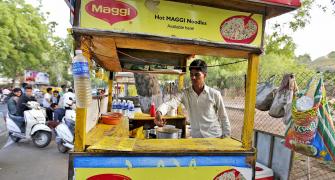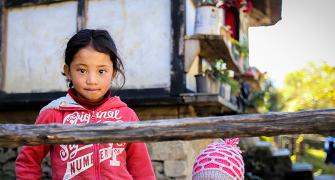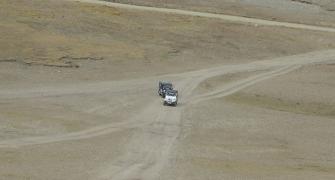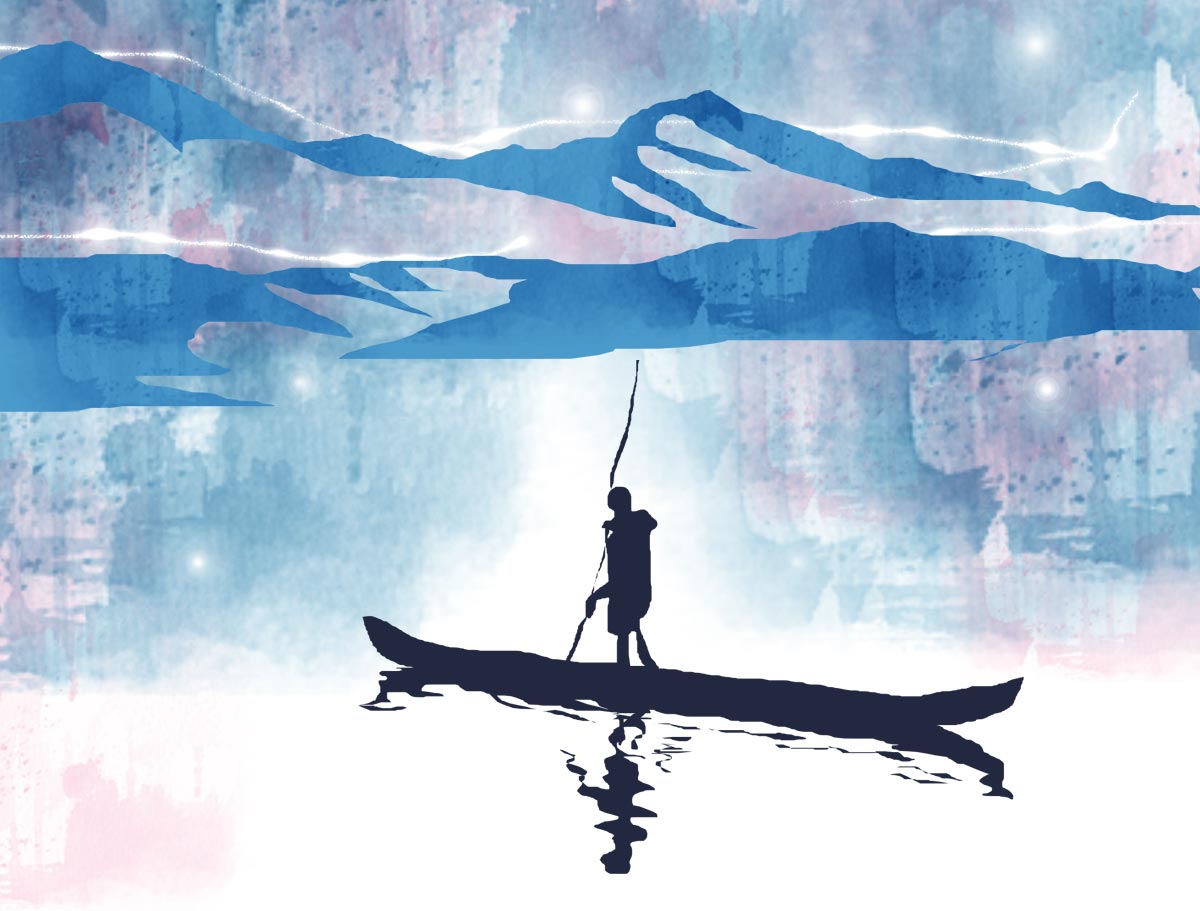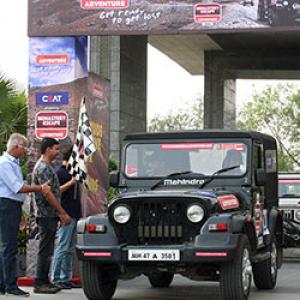Rajesh Karkera journeys through verdant countryside to the little-explored pristine Lonar lake in eastern Maharashtra.
5.30 am
After driving on empty morning roads in Lonar village, we have chai cravings that lead us to a bhatti in one of the bylanes of the market area of Lonar village, the interiors from which smoke is luxuriously billowing out.
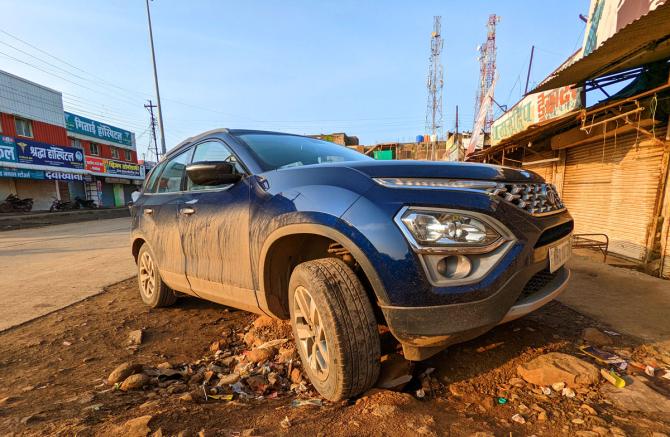
I park the Safari on the main road. It isn't advisable to take the Broad Blue Beast into the bylanes even though they are deserted.
The bhatti is serving local breakfast with tea, of course.
Deep-fried Dal Wadas -- a very different variety from what we get in Mumbai or down South.
And some pakodas, supposedly Palak Pakodas. But there is barely any palak (spinach) in them.
Still, this is fun :)
It is time to head back to the resort for some proper breakfast!
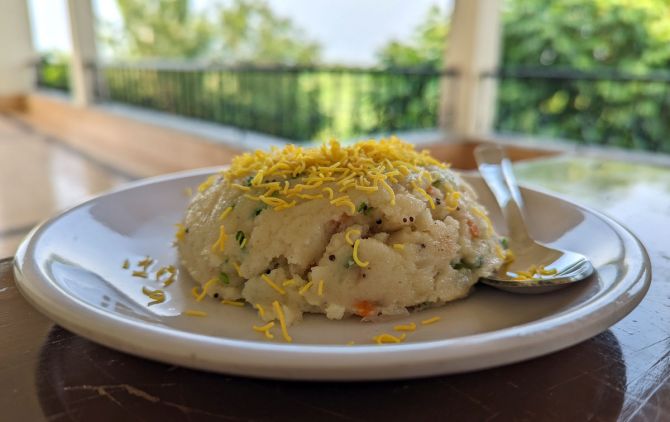
The breakfast at MTDC, which is included in the room charges, is simple. Yet fresh and healthy. We opt for the poha and the upma. It is served up piping hot, in the huge dining room they have on their premises on the first floor. It overlooks the jungle around the crater, which is an enticing lush green.
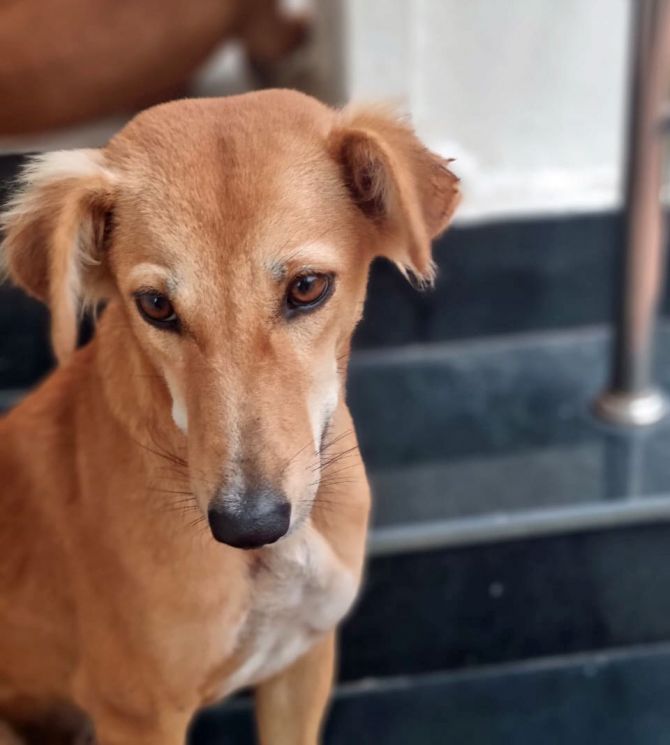
Meet Crater, one of the pets in the compound. We named her.
There are two others. A black boy named Singham and a brown female named -- what else? -- Rani.
All three are the in-house pets here and are extremely gentle.
These fellows do come up to the dining area. But only if you want them to. If any guests are afraid of canines, the staff sees to it that the dogs do not disturb them.
9.00 am
Second breakfast done. Off we go, along with our local guide Shailesh Sardar who helps us see and understand what Lonar is all about.
We first head to Viraj Tirtha, also known as Lonar Dhar. This temple or door to Lonar, as you could call it, is a shrine which has lots of sculptures on its walls and pillars. But what catches the eye is the continuous flow of water into a tank which is considered holy.
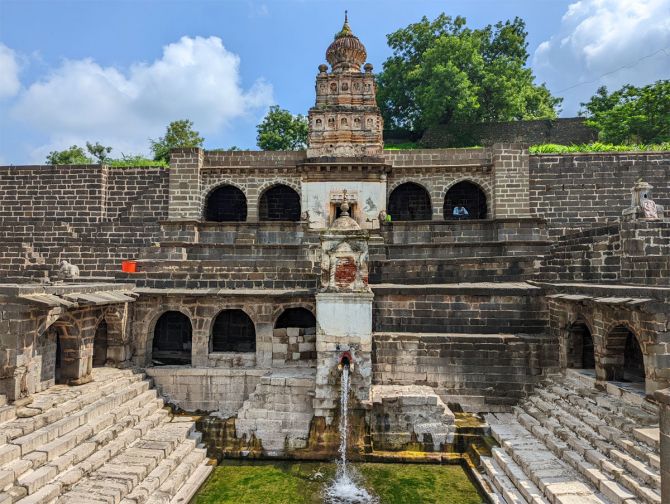
Since we are coming here not that many months after the COVID-19 lockdown, the tank has not been opened to the public.
That is a good thing actually -- else you would have seen here hordes of people bathing and washing clothes, clouds of foam and not this spartan tank beautiful in its splendid isolation.
It is said that the water has been flowing into this kund (tank) for thousands of years.
Till here is the easy part...

Now what you see behind us is the path down through the forest to the lake that we need to negotiate:
Going down to the lake is not at all gruelling. And the path in the monsoons is green and dreamy.
But it's not just the lake that you should see in these parts.
Take a guide along and you will be shown a lot more!
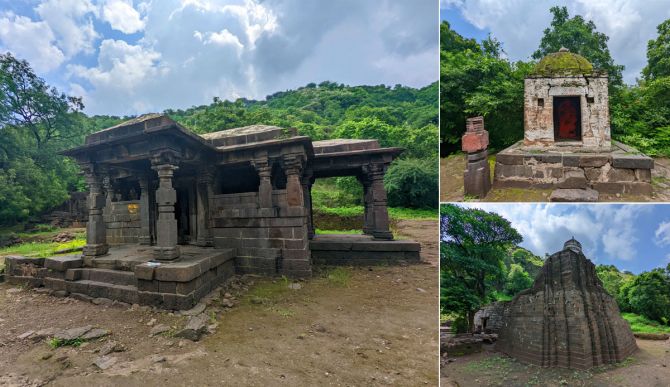
There are temples along the circumference of the lake -- all around the place where the meteor hit.
They are carved completely in stone. Some are in shambles. Others restored.
As, one by one, you see them, you realise that these are not just places of worship. They were, at one time, places of meditation and studies.
Along with the temples, are vachnalays (reading rooms), built completely out of rock and even a shelf made from rock to probably keep books and an oil lamp.
There's a meditation room, totally dark, with a shivling inside. Even so, the place is not a temple. It was where people meditated alone, apparently looking at the size of it. There are no lights inside or windows. It is pitch dark. Carrying a flashlight will surely help.
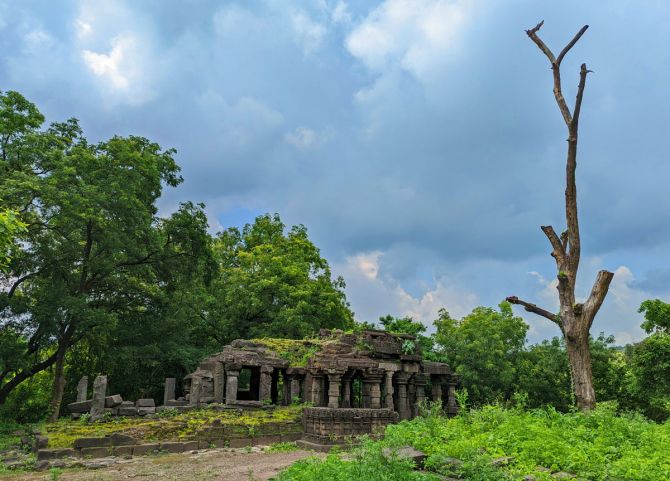
As you walk towards the lake, which is approximately an 8 km trek, you come across several varieties of temples. Each one has a very different vibe. There are a total of 15 temples built around the edge of the crater.
One of the temples, which looks simple on the exterior, made our compass go haywire.
The reason: Our guide Shailesh tells us that one of the pillars of this temple, which is all made from rock, is magnetic.
Would you ever know this if there wasn't a guide accompanying you?
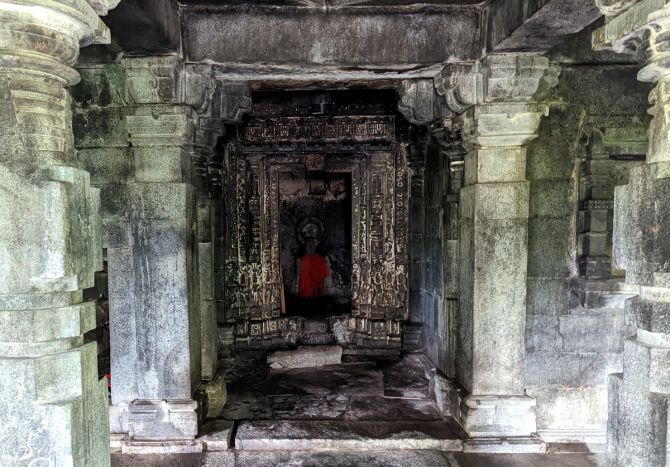
This is unique (above) -- a shrine of Lord Ram alone in a temple. Normally, Shailesh explains, it's always Ram, with Lakshman and Sita beside him. Here he is alone.
I am asked to stand close to the entrance.
Suddenly I see my own shadow. But multiple shadows. Three to be exact. One falls on the god in front and the other two fall beside the statue. Bewitching. Magical. It's a wonderful scientific creation by the sculptors of that time.
They built this temple in a manner that at any time of day, every time someone stands at the entrance, three shadows will fall on Ram -- making you feel like you have Ram, Lakshman and Sita within you... Something to ponder over.
So well designed is this temple, that even if you don't have someone guiding you -- where to enter from, the carvings on the stone lead you to it. You just have to look.
After our visit to the Ram Gaya temple, Shailesh leads us through the stone and loose soil-covered approach and then on a green path towards the lake.
Ah, the lake...
It is a sight to behold. One of the great visions of a lifetime.
The Mysterious Mystical Lonar lake is surrounded by its brood of companion temples.
This is our endpoint. Our high.

After several moments of contemplation and reverie, it is time to head back, very thankful to nature for having had the patience to let us see all this with ease because just as we are turning around, on cue, thunder and a drizzle of rain start up.
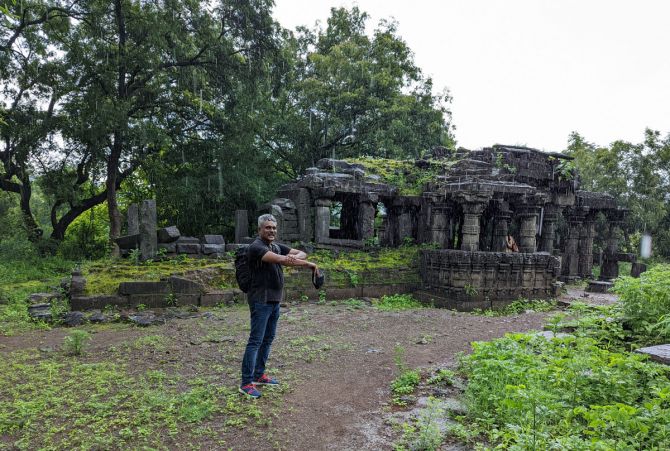
We wait almost 30 minutes for the rain to let up. It didn't -- a return trek in the rain.
And this I enjoy. The last bit.
The climb back up to Viraj Tirtha or the Lonar Dwar. It is a task!
Water gushing down the stones. My shoes filled with water making my feet heavy.
And the stone steps are not your normal height of steps.
But take one step at a time. And you will reach the top with ease.
That's what keeps us all going. Just don't look up till you reach the top!
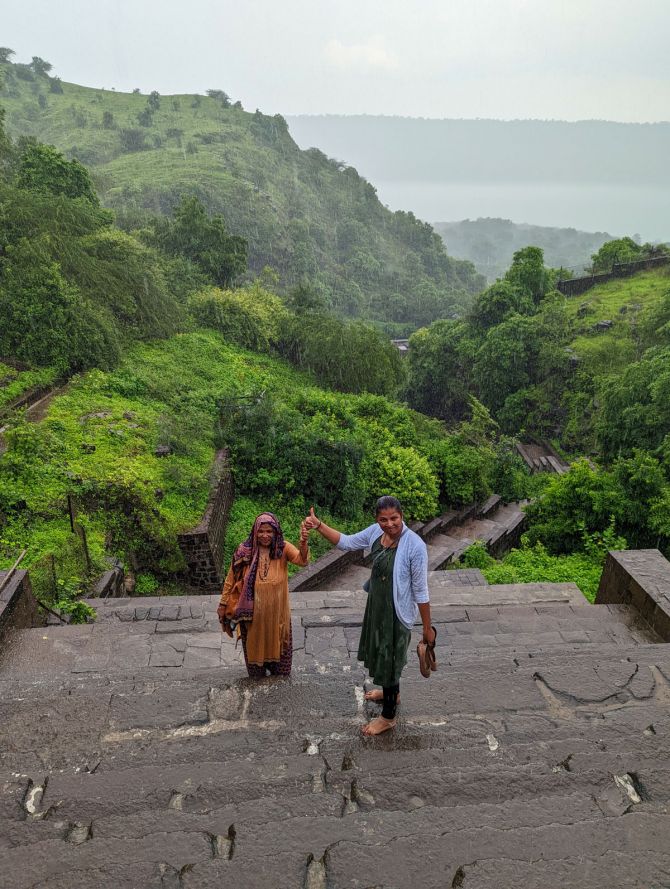
What a feeling it is to come back to the top!
With us are trainee women Maharashtra government employees, who are stationed in Lonar, and this is their first weekend off. And they choose to do this trek. Kudos to them!
Completely drenched, our footwear squelching, we reach the MTDC hotel to freshen up and get some lunch.
Post lunch and a half hour of rest it is back to seeing more of Lonar.
Enthusiastic Shailesh insists we leave by 4 pm latest as he wants to take us to see a good view of the lake and one more temple before nightfall.
4.30 pm
We leave MTDC, the same convoy of three SUVs, one behind the other.
The first place the guide takes us this evening is to a great spot to photograph Lonar lake.
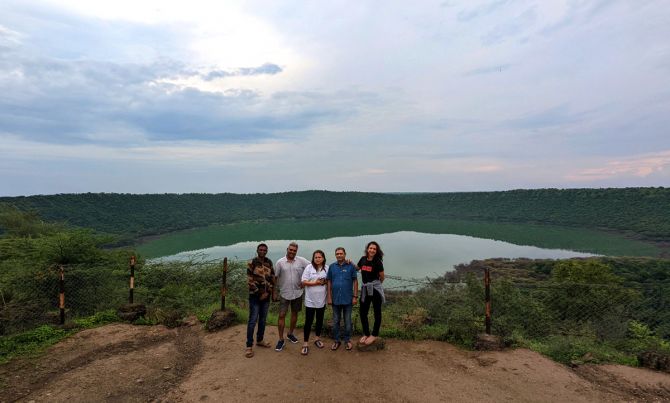
It's an unobstructed panoramic view of the complete lake and its surrounding forest. Breathtaking!
Every time you visit this same spot you will see a different picture, different vista, and different frame -- all because the ethereal clouds and the elegant sky, above, surround Lonar lake in a different, out-of-the-world kind of way.
Almost as if some sci-fi activity is happening here. Especially in the mornings and evenings, I feel like I am in an extra-terrestrial film.
Shailesh narrates the Story of Lonar at the lookout point. It is said that a meteorite hit this part of Lonar about 56,000 years ago, creating the largest impact crater in India and the third largest in the world. Now after some new research done by scientists who frequently visit Lonar, they are coming to the conclusion that this impact was not 56,000 years ago, but more like 570,000 years ago!
The asteroid that fell was 60 metres in length and weighed a mind-boggling 2 million tons.
At this viewpoint, the Geological Survey of India erected a signpost in April 1975 which describes the Lonar crater to be the only hyper-velocity natural-impact crater in basaltic rock (a kind of igneous rock) in the world. It takes a lot of scientific reckoning to decide whether any large depression on the earth's surface is a crater or not. Lonar is therefore one among some 20 very large earth craters that has been established to be a bonafide crater. The largest in the world is Vredefort crater in South Africa with a 160 km diameter and Lonar at 1,830 m is in august company.
Please see the video below in which Shailesh explains how the Lonar crater came to be:
As we leave this viewpoint, I couldn't help but notice a structure in ruins.
It looks like barracks.
Only after I enter do I realise that this was once the PWD Guest House (please see pic below) and it was where I was first considering staying, as this is the only place that has a direct view of Lonar lake.
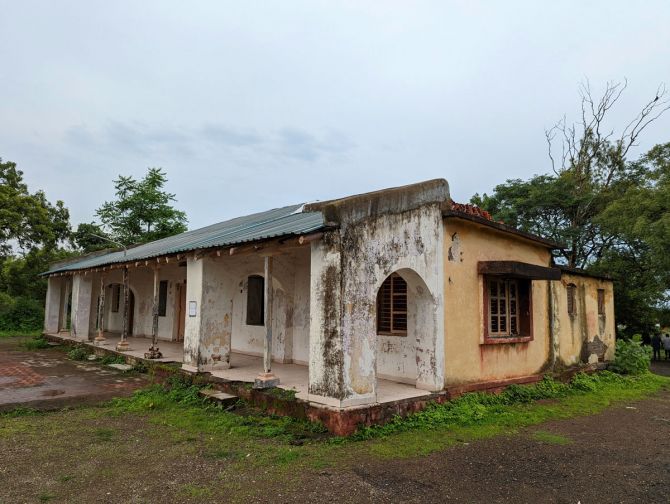
But after COVID-19, everything is shut here. Vehicles once got access to the viewpoint. No more.
There were safaris and treks organised for tourists which took them right to the rim of the lake through the forest. It all stopped after lockdown and it's not resumed yet.
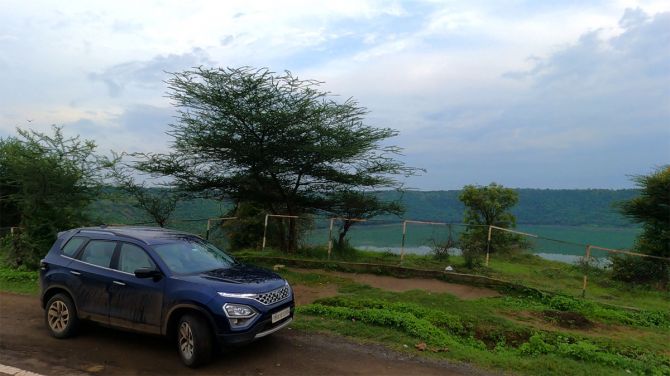
After taking a few very tough, hard-to-organise-angle shots of our cars, with the lake as the backdrop, we visit a privately-owned Hanuman temple.
In this temple, unlike other Hanuman temples, the statue of Hanuman here is lying down and has anger on his face.
This temple doesn't have any caretakers to bother you for money -- anyone can just walk in, pray, look and go. It feels nice inside .

So, the history goes: This statue of Hanuman is made from magnetic basalt rock and has the same magnetic field that some of the pillars of the temples around Lonar have. Some even consider that a visit to this temple will relieve them of blood pressure and stress issues.
A few years back, the statue was all covered in orange tikka powder, which all Maruti temples have, and as a result, no one had seen the actual stone statue for years and years.
It was only when the Kanitker family, who are private owners of this temple and premises, decided to remove all the orange paint, that they saw the actual statue and discovered it was of Lord Hanuman, in an angry avatar.
Next is our last stop -- so says our guide. Our three monstrous SUVs end up blocking every narrow street of Lonar market!
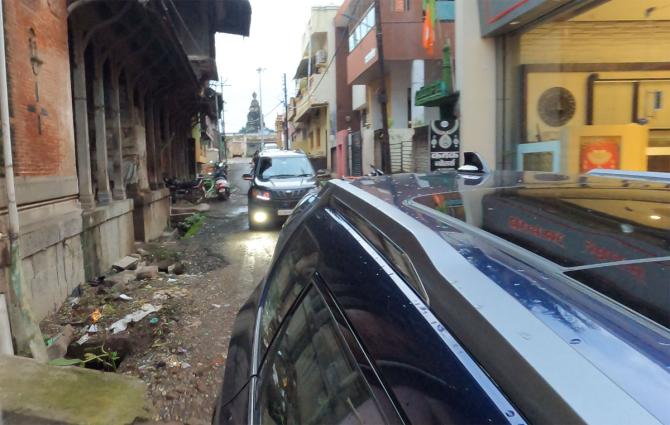
But from what we could see, old Lonar is a town of lovely houses along both sides of the street, a mixture of the old and new. The old is fading, crumbling away, but people are still living in the rundown homes.
6.20 pm
Our last destination of the day: The Daitya Sudan Temple. This is a familiar structure, so similar to the temples of Khajuraho. The carvings and the shape of the temple is very much the same.
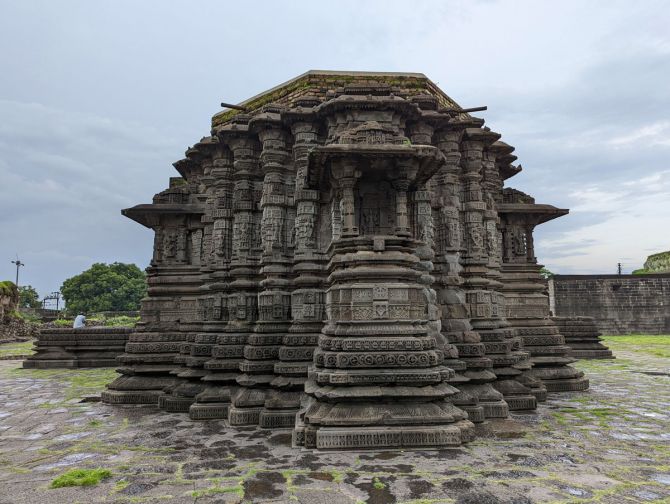
Excellent sculpture. Each depicts something from that era and just like the Khajuraho temples, the sculpture was desecrated apparently by the Mughals in the 13th century.
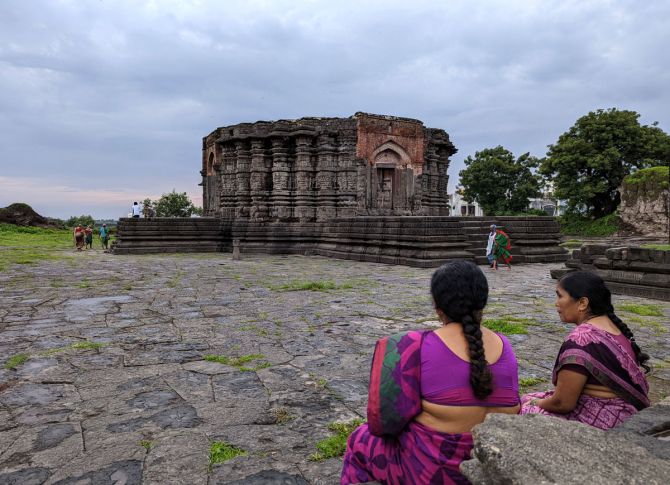
After spending quite a bit of time here, as the daylight waned, it is time for us to head back to our MTDC lodging.
Winding our way through the narrow lanes is smooth, as most of Lonar and the market too shuts down early. This made the streets easily passable for three enormous SUVs.
On our way back, the twilight sky is so majestic, that I just have to stop the new Safari in the middle of the road to take this shot:
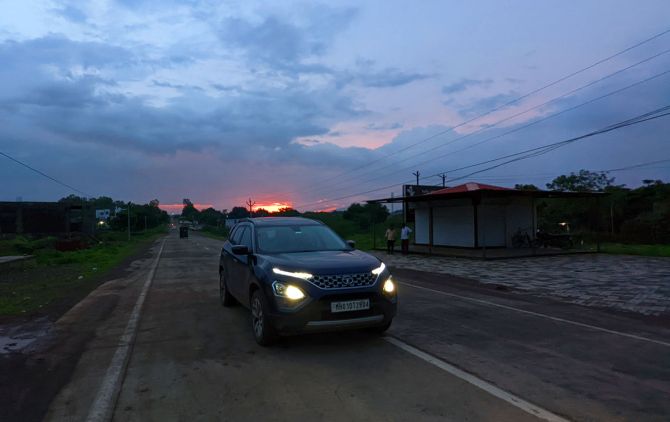
People started wondering if this man -- me -- is going mad! My co-passengers, Rohinton and Shailesh our guide included.
Back at MTDC, a scrumptious meal is waiting for us. All thanks to the manager Vaibhav and chef Mahadev, who see to it that the meal for our second night is completely different: Baingan Masala, Bhindi Fry, Varhadi Chicken -- This is a speciality zesty and spicy flavourful dish from the Vidharbha district of Maharashtra, A must try for one with a spirited palate, Plus dal, rice and chapatis too.
All excellent. And not to forget: French Fries again!
No pictures this time. We were just too hungry to wait!
6.30 am
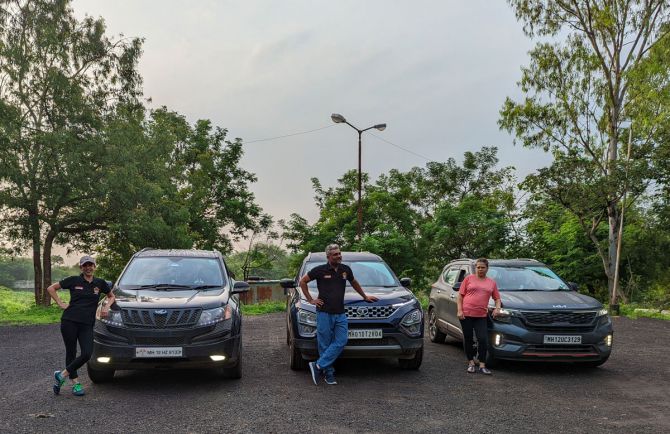
The next morning and it is time to depart Lonar. The sad truth about every trip: We do have to return.
Yet the good thing about being on a road trip is that the fun doesn't end till you reach your parking spot at home.
The way back too is full of adventure for me.
It starts almost immediately after my friends from Pune part on to their different routes.
Google maps takes me on a path which literally has no roads. And me, being the off-road junkie that I am, just kept going, even though I knew it is the wrong way.
I am enjoying the way the New Tata Safari is handling the no-roads situation.
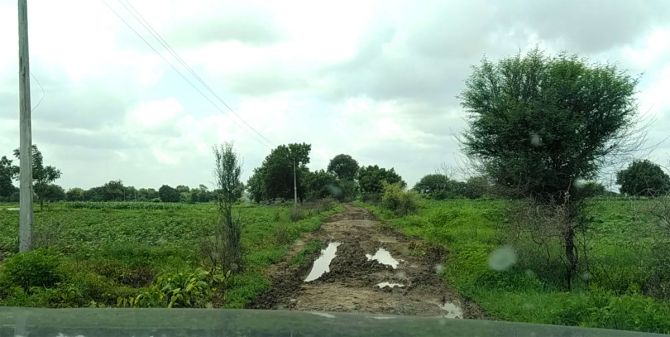
After continuing on the mushy, slushy path between fields for almost 38 minutes, I am frantically waved down by some farmer women, who are working in the khet.
I stop and shut my music to listen to what they are saying: "Phude gaadi zaanar nahin, fakta chalun jaaoo shaktat (The car won't go ahead. There are no roads... You can only walk)"
I start laughing and thank them.
Now there is no way I can turn this Blue Beast around as on both sides the bushes/trees are too close to the car to take a U-turn. So instead, I choose the rough terrain using the mode selector on the car and drive all the way in reverse. Till I get some space for a U-turn.
What fun!
At a junction I see two villagers, looking strangely at me, watching my antics. I greet them and ask them the way to the highway.
The duo point and say that it is 9 km that way.
They then request if I can drop them off at the highway as they are going to their shop there. My car is empty and they seem like nice people, so I ask them to get in.
After a little chit-chat, I put it to them: Is there a way to not join the highway but to go through villages ahead and then reach the highway?
They nod their heads enthusiastically and say: "Yes, yes" and take me through a bunch of lovely villages. It seems like everyone knows everyone around here. People are greeting my new passengers as we pass.
Some even shout, 'HAAARIER' (the New Safari is often confused with the Harrier in many parts). But basically these new Tata cars seem to be head turners everywhere.
After a good drive, we reach the highway, where I drop them off. They insist I have tea in their home. I respectfully tell them I need to be on my way.
The people of Lonar and the villages nearby, you discover, are simple, helpful and caring. When we created an almighty traffic jam in Lonar market no one was upset with us. Every person, whether walking or driving, was helping us pass.

I just HAD to take this picture of the car on these tracks which are very close to a railway station named Potul, in Gangapur taluka, Aurangabad district, on the Mumbai-Nanded-Manmad line. We cross this rail line just before reaching the highway.
Kindly note: I did request the official on duty for permission before I stopped midway on a railway crossing to take it.
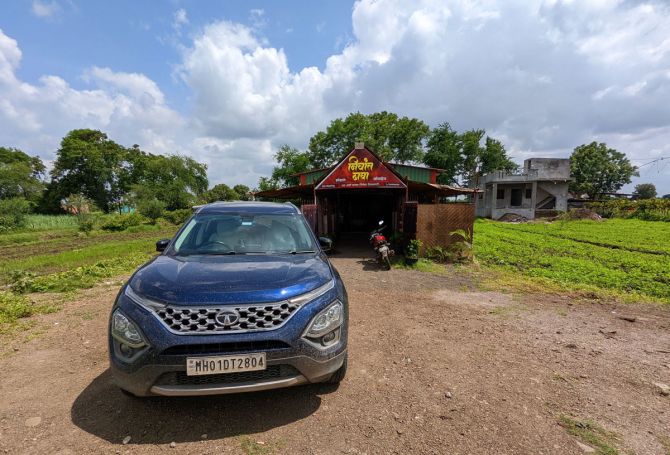
I make one more stop on my 497 km drive back to Mumbai -- for lunch. It is a place called Nivant Dhaba, serving Malvani thalis.
At least that is what the hoarding says. The food is a delicious home-style fare.
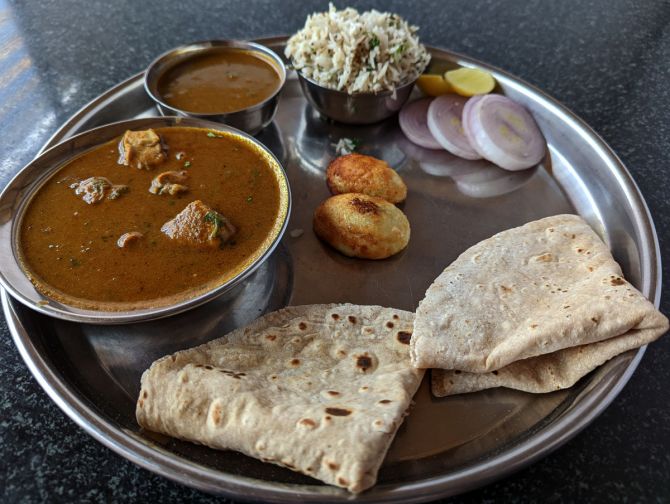
After my meal, I thank the staff and I discover that this Maharashtrian ghar-ka-khana place is run by a father-son duo from Nepal, who cook perfect Malvani fare. I thank them for the food and am on my way back on the road.
6.20 pm
There is a major traffic jam at Bhiwandi, near Mumbai. Back to 'civilisation'. Sigh.
I wait patiently for a few minutes and then have a look to see the cause. Huge, ugly unlike-Lonar crater potholes are holding up the traffic as they try to make it across.
Hmmmmmmmm, I think to myself. I am road-testing the New Tata Safari which has terrain response drive modes.
All I do is switch the mode using the dial on the centre console from 'city drive' to 'rough road' mode and request a biker family to give me some way, thank them, crank up the music and ride the craters like a horseman would steer an untamed bucking bronco!
Everyone thinks I am crazy! But I am out of the jam in under five minutes. Some of the passengers in a bus I pass actually clap! Hahaha.
8.02 pm
Home! My odometer clocked an impressive 1051.2 km in 72 hours. The pyara Blue Beast did well.
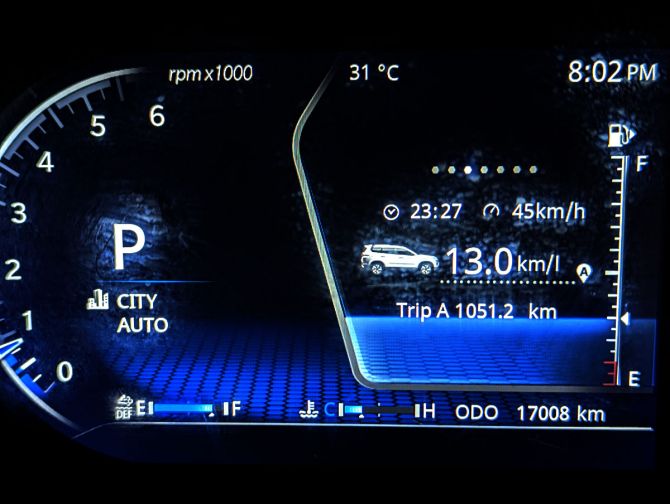
And no, I am not tired at all -- I am good for another drive, which I do.
I go on a 5 km drive to IC Colony, Borivali, to get some top-class Roast Pork Chilli from Uncle's Corner, to bring home for dinner.
I could have ordered it on Zomato or Swiggy, but then where's the fun of that last extra drive with dear BB.
Now for the facts...
North Mumbai to Lonar: 497.8 km
Pune to Lonar: 357 km
MTDC stay:
Manager Vaibhav Jumbade
Super Deluxe Room AC: Rs 1900 per day inclusive of breakfast.
Lunch/Dinner: Extra. Rs 800 per day all told for four of us, including soft drinks.
Service: Friendly. Excellent overall.
Important Note: Order food/drink in advance.
New Tata Safari performance facts:
On highway: Very stable and with a good hold on the road. Enjoyable drive.
On bad roads: The three-drive mode dial switch of the New Tata Safari is particularly handy.
Music system: The JBL sound system gives you that extra boost of thumping energy that is needed on a road trip.
Fuel economy: 13 km/l diesel.

